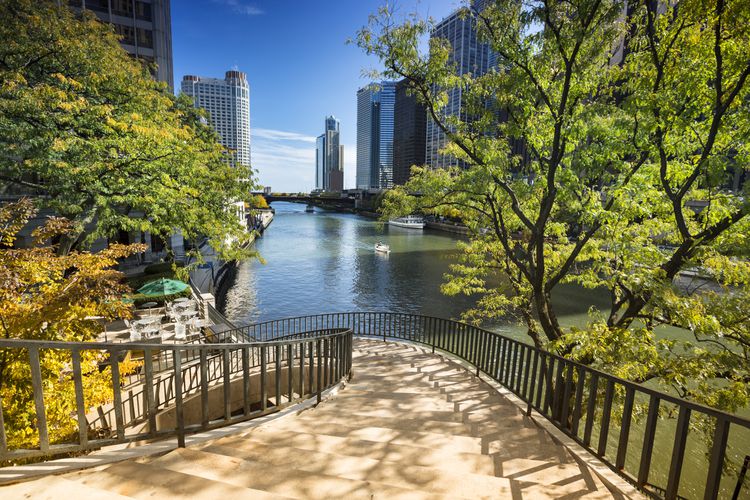Summary
The Chicago river winds its way through the city and is a big part of the Chicago landscape. Every year on St. Patrick’s Day, the river is dyed bright green, and there’s a collection of boats and kayaks on the water daily. In 2016, Mayor Rahm Emmanuel transformed the 1.25-mile-long path into a riverfront destination filled with restaurants, art installations, bars, and more. Find out everything you need to know about the Riverwalk, including what to do and how to get there.
History
For many decades, the Chicago river was best known for being so polluted that no aquatic life could survive. The river played a crucial role in fueling Chicago’s industry; however, sewage and factory waste rendered it toxic. The river’s flow was reversed in 1900 to prevent contamination of Lake Michigan, but it took over 100 years for it to become somewhat habitable. In 2015, Mayor Emmanuel announced revitalization plans, aiming to improve water quality, reduce pollution, and integrate the river into city life. The following year, the new Riverwalk opened, establishing a must-visit destination with top-rated restaurants, museums, and various water activities. Since then, the number of vendors has continued to grow.
Getting There
The Riverwalk stretches along Wacker Drive from Franklin Street in the West to Lake Shore Drive in the East. For those taking public transport, the State/Lake station services the Brown, Pink, Orange, Purple, and Green lines. A short walk north on State Street and down the ramp will lead you to the midpoint of the Riverwalk. The Clark/Lake station, located further west on Lake Street, is serviced by many lines as well. Alternatively, to start at the Riverwalk’s beginning or end, the 125 bus to Wacker & Orleans/Franklin stop allows you to traverse the entire 1.25-mile path.
If you are traveling via Metra, the Ogilvie Transportation Center is nearest to the Westernmost point of the Riverwalk. A short walk north on Canal Street, then a right on Lake Street, will lead you to Wacker Drive and the Riverwalk ramp. Millenium Station is also accessible; you can walk north on Michigan Avenue for three blocks until reaching the river. Make sure to use one of several accessible entrances, which are available by State Street, Clark Street, and Franklin Street.
If driving, there are numerous paid garages in the vicinity. Additionally, metered parking is found on the Lowest Level of Wacker Drive, but be cautious as Lower Wacker can be confusing, and GPS often provides inaccurate guidance.
The Chicago Water Taxi makes various stops along the Riverwalk, reaching up to North Avenue and down to Chinatown. One-way tickets cost $6, while all-day passes are $10.
Things to Do
The Riverwalk offers a wealth of activities and sights. Visitors can dedicate an entire day to exploring Chicago’s architecture, enjoying meals, and leisurely strolling along the waterfront. Starting at the western end, one of the first attractions is the floating gardens. These beautiful gardens not only enhance the visual appeal but also play a vital role in purifying the river water, thereby improving the living conditions for its aquatic life.
Most Riverwalk establishments operate seasonally, closing from November to April. You can find small food stands such as Frost Gelato, renowned for its sweet Italian dessert, as well as outlets of larger establishments like City Winery. During the warmer months, patrons can enjoy outdoor seating by the river, sipping sustainably produced wine. When temperatures dip in October, City Winery offers a heated glass enclosure for diners and special igloo-like River Domes for an intimate experience, featuring best-selling dishes from their West Loop location alongside excellent wine.
A variety of cruises and water taxis also dock at the Riverwalk. For an immersive architectural experience, consider taking a tour on the First Lady vessel. Certified guides provide insights about over 50 notable buildings while guests enjoy drinks from a fully stocked bar. This 90-minute tour runs daily from March onward, with tickets costing $49.48 and available for purchase in advance.
The McCormick & Chicago Bridgehouse Museum invites visitors to explore the inner workings of a bridgehouse, featuring massive gears controlling the DuSable bridge. The museum boasts 360-degree views from the top and is open Thursday-Monday from May to October, with an admission fee of $6 for adults and reduced rates for seniors and children. Admission is free on Sundays, although ticket prices increase for access to bridge lifts and tours.
If you wish to get up close to the river, visit Urban Kayaks at the eastern end of the Riverwalk. They offer tours and rentals catering to all ages and skill levels, making for an enjoyable water activity. You can experience the stunning Chicago skyline during sunset or embark on a 90-minute historical tour; both cost $65, with shorter introductory tours available for $45. Hourly kayak rentals are also an option at $30 per hour per person.




